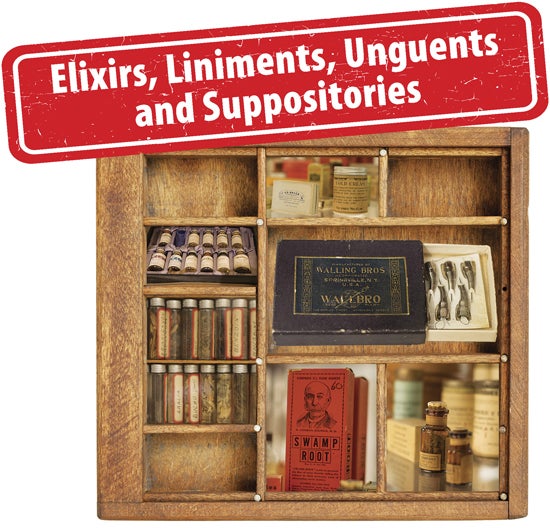
Want to feel better? We’ve always sought out cures for what ails us, from village herbalists, shamans, apothecarists and doctors.
A big spoonful of progress came during the Industrial Revolution, when New England emerged as a center for the burgeoning pharmacy trade, which was then extricating itself from medicine and becoming a science in its own right.
The small druggists that anchored every community are mostly gone now. But scattered among the modern lines and 3D printed molecules that grace URI’s new $75-million pharmacy building, their artifacts linger, reminders of this most intimate thread of our history.
“They’re the link between old and new,” observes Norman Campbell ’56, a former URI pharmacy professor and dean, as he admires the displays he helped create.
Many remedies are small monuments to inventive marketing. Of the many flavors of Humphreys Pills, for instance, huge numbers branded each use: #77 was for the common cold, #31 for painful menstruation, and #27 for disorders of urine. In other cabinets, the mysterious Sanitube for Masculine Hygiene sits alongside molds for making pills and suppositories.
“Rhode Island was a hotbed for patent medicine manufacturers,” says Anthony Palmieri ’71, a retired pharmacy professor and director of the University of Florida’s pharmacy museum, who with many other alumni has contributed to the URI collection. “They typically contained an awful lot of alcohol, which was pretty good for patients because while it might not help you, at least you didn’t mind having the disease.”
The collection contains larger monuments, too. The lavish door surround that now guards the dean’s office displays the elaborate carving, rich hues, and shelves of glowing liquids that once telegraphed the well-heeled importance of the druggist’s workshop. The family artifact was donated by Peter DiCristofaro ’75, a pharmacist at Rhode Island Hospital.
Since that door was built, crusading pharmacist politicians pushed for the sweeping drug regulations that put many medicines behind a prescription wall, family-owned pharmacies were swallowed by mega-chains, and we’ve developed access to a dizzying number of precisely manufactured medications, with more constantly under development.
“Medicine from plants is still expanding,” says pharmacy professor David Rowley. “More than half of modern drugs are inspired by molecules in nature. It’s a rich history for which URI has been well known for decades.” •
—Pippa Jack
 Home
Home Browse
Browse Close
Close Events
Events Maps
Maps Email
Email Brightspace
Brightspace eCampus
eCampus


